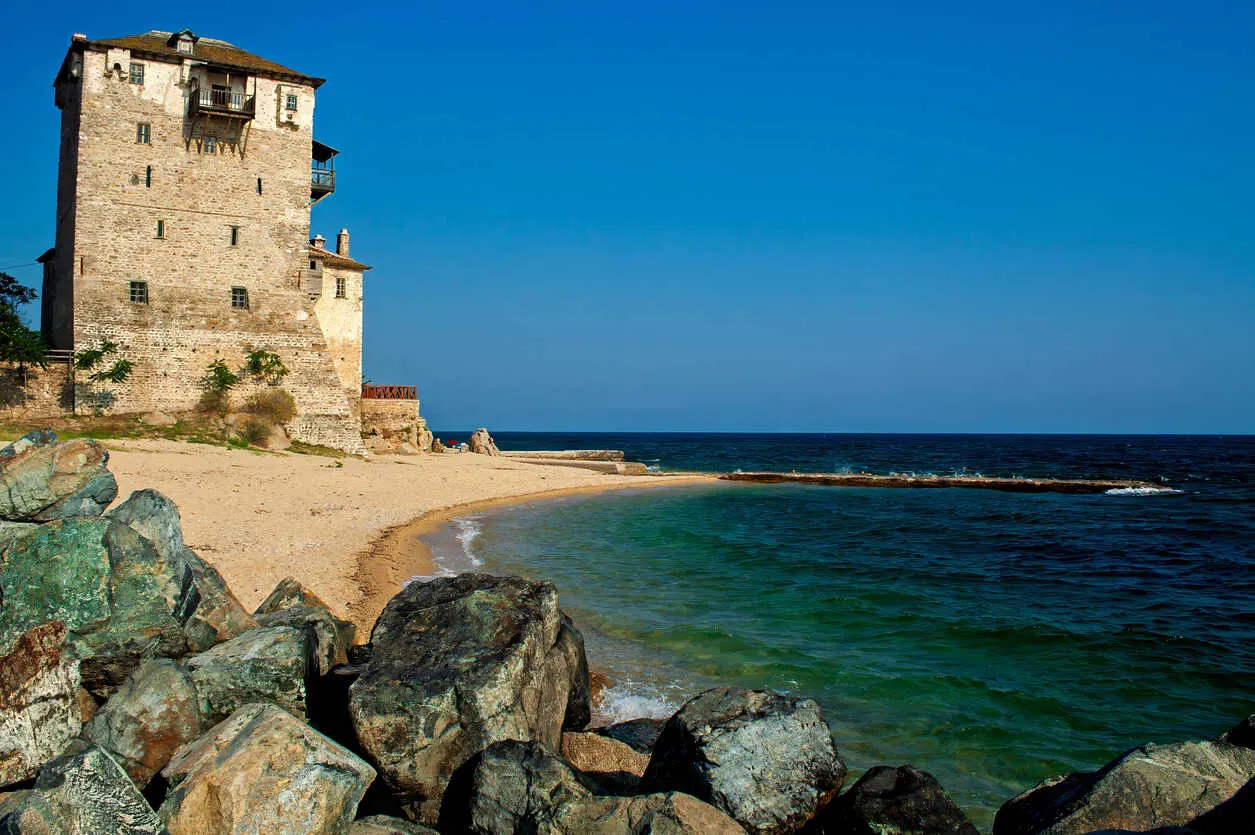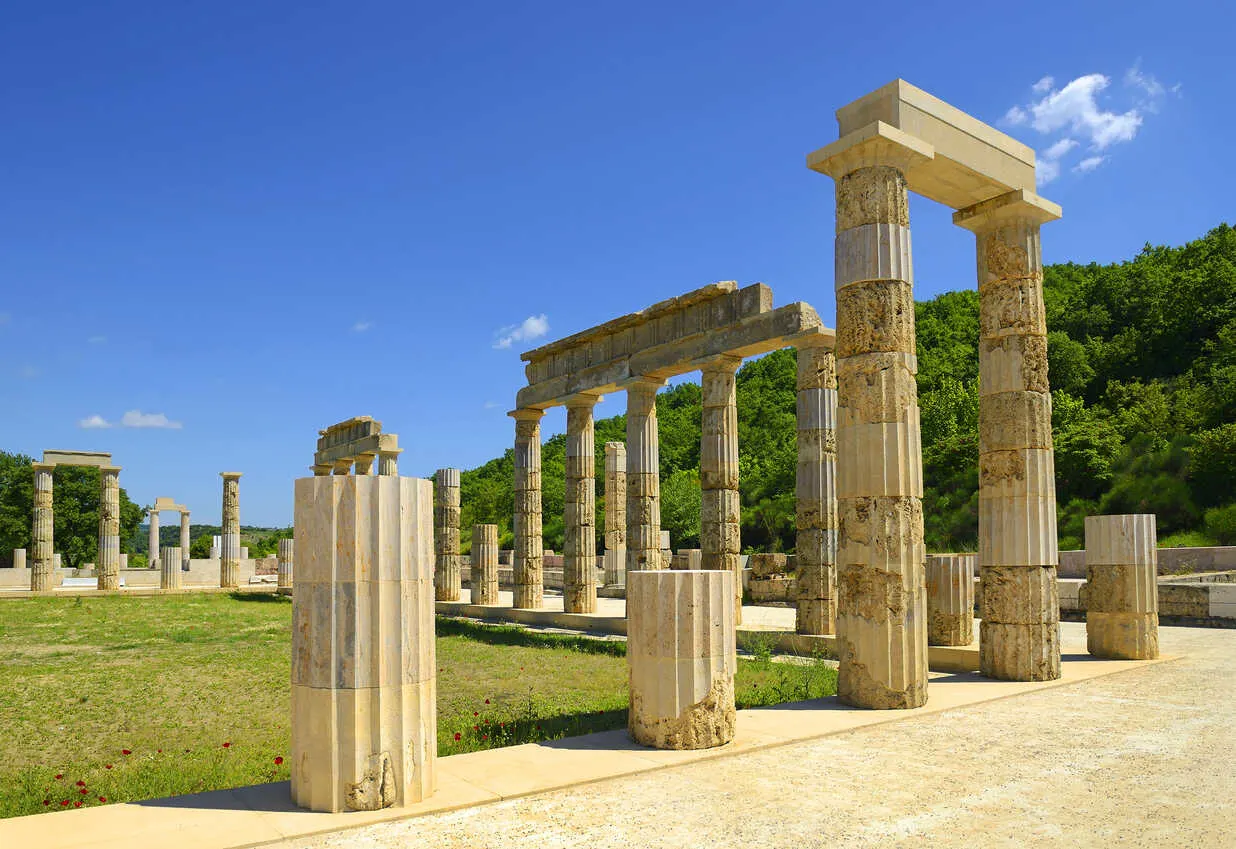When people travel to Greece, they often visit iconic spots like the Acropolis, Mykonos, or Santorini, overlooking less familiar areas. They don’t know what they’re missing. During my recent trip to northern Greece, I ventured off the beaten path to discover fascinating places that few travelers ever experience.
My journey through eight little-known towns spanned centuries of history. I walked in the footsteps of Alexander the Great and Paul the Apostle and visited monasteries dating back to the 11th century.
I navigated mountain villages with streets so narrow that I questioned whether my rented Volkswagen Polo would fit. Hugging the coastline, I encountered breathtaking scenery where steep, rocky shores met the cerulean Aegean Sea, laced with shades of indigo and turquoise.
The adventure began in Thessaloniki, Greece’s second-largest city. From there, I drove east toward Halkidiki, a region with three peninsulas that extend into the Aegean Sea: Kassandra, Sithonia, and Mt. Athos.
Get Your Free Greece Report Today!
Get Your Free Greece Report Today!
Learn more about a slower pace of life in Greece and other countries in our free daily postcard e-letter. Simply enter your email address below and we'll also send you a FREE REPORT — Retire in Greece—Find Your Dream Retirement in This European Archipelago.

By submitting your email address, you will receive a free subscription to IL Postcards, Overseas Dream Home, The Untourist Daily and special offers from International Living and our affiliates. You can unsubscribe at any time, and we encourage you to read more about our Privacy Policy.
Galatista
My first stop was Galatista, a tiny mountain town with impossibly narrow streets, historic houses, beautiful churches, and a charming town square. The public fountains scattered around town caught my eye, many adorned with paintings by local artists.
The town’s most prominent feature is the Byzantine Tower, built in the 11th century. It’s one of the best-preserved towers in northern Greece. Historians believe it was likely used for water storage, given its proximity to two water mills, an olive press, and a wine press. Tours are available daily from 8.30 a.m. to 3.00 p.m.
Parking is scarce in Galatista, so I recommend parking in the town square or along the road near the tower turnoff.
Psakoudia
Next, I arrived in Psakoudia, a seaside town located midway between the Kassandra and Sithonia peninsulas. I stayed at the Philoxenia Hotel, which became my base for exploring Halkidiki.
Psakoudia is ideal for sightseeing, offering easy access to all three peninsulas. Visitors flock to Halkidiki during summer for its luxurious beaches, lively beachfront bars, and wellness centers like the Thermal Spa of Agia Paraskevi.
Ouranoupolis

My first excursion took me to Ouranoupolis, or the “City of Heaven,” on the Mt. Athos peninsula. Just an hour’s drive away, the route offered smooth roads, scenic views of hilly pine forests, and glimpses of the Aegean coast.
Founded in 315 BC on the ruins of an ancient city, Ouranoupolis is known for cruises to the monasteries on Mount Athos, a UNESCO World Heritage site. I boarded a boat from Mount Athos Cruises and chatted with passengers from across Europe as we sailed along the coast. The monasteries, perched high on cliffs above the Aegean, were awe-inspiring even from 500 meters offshore.
Women are not allowed on Mt. Athos, and men require special permission. Boats must stay 1,500 feet from shore for religious reasons.
Afitos
The following day, I visited Afitos, one of the most picturesque villages on the Kassandra peninsula. Perched on a cliff, it offers stunning views of the Aegean Sea and Sithonia. Its cobbled streets and stone buildings begged to be explored.
In the town square, St. Demetrius Church, built in 1858, stands on the ruins of an older church destroyed in the Greco-Turkish War. Inside, a 14th-century icon of the Virgin Mary, crafted in Constantinople, draws visitors.
Walking left from the square, I reached an overlook with panoramic views of the Aegean and several restaurants serving local delicacies like spanakopita and souvlaki.
If you decide to stay overnight, the Blue Bay Hotel has comfortable, reasonably priced rooms with gorgeous views of the Aegean Sea.
Ormylia
I spent the next day with my friend Sofia, and we visited Ormylia and Polygyros. Ormylia is a small village near Psakoudia surrounded by olive groves, pine trees, and mountains dotted with windmills and stone churches.
Its main attraction is the Holy Monastery of the Annunciation, Greece's largest women’s monastery. Over 100 sisters from around the world live there and have jobs according to their talents and interests.
Some cultivate organic olives and produce the monastery’s own brand of extra virgin olive oil. Others make honey, jams, liqueurs, and personal care products such as soaps, lotions, and ointments.
Sisters who enjoy crafts carve religious icons out of wood or make vestments with fabric they make by hand on old looms. Those who are musically inclined are famous for their beautiful chanting and have published several CDs and DVDs.
The monastery is open on Tuesday, Thursday, Saturday, and Sunday from 11:00 a.m. to 3:00 p.m. and for prayer services on major religious holidays. If you’d like to spend the night, call (30) 237-104-1278 to make a reservation. Plan ahead because there’s a six-month waiting list.
Polygyros
Our next stop was Polygyros, a mountainside town built like an amphitheater. Its name derives from poly (many) and gyros (rounds), reflecting its tiered, circular layout.
Polygyros is known for its Macedonian architecture, with homes featuring stone ground floors, wooden upper stories, and wide balconies. We stopped at Andreadi Patisserie for coffee and pastries to take a break from walking up and down the town’s hilly, cobblestone streets. Later that afternoon, we had an authentic Greek lunch at The Marigoula.
Vergina

Leaving Halkidiki, I headed west past Thessaloniki to Vergina, the original capital of Macedonia and Alexander the Great’s childhood home. At the Royal Tombs of Aigai Museum, a UNESCO site, I saw the tomb of Philip II and treasures unearthed from the ancient city.
On the way to Veria, I stopped at the New Polycentric Museum of Aigai, which is located at the original site of the Royal Palace of Macedonia. A large atrium shows a restored portion of the palace's upper floor. Other exhibits display tools, household items, and objects used in religious ceremonies and provide insight into life during the time of Alexander the Great.
Veria
After a short drive, I arrived in Veria, the final stop on my Greek odyssey. From the 11th to the 14th century, Veria was the third most important city of the Byzantine Empire, following Constantinople and Thessaloniki.
I met my friend Ioannis to delve into Veria’s rich Christian and Jewish history. He described Veria as the “cradle” of Christianity in Greece, where residents were notably receptive to the teachings of Christ compared to other cities.
The Apostle Paul visited Veria in 50 AD and 57 AD during his travels from Asia Minor to Greece. Our walk through the Christian quarter culminated at The Tribune of Apostle Paul, the spot where he preached the teachings of Jesus Christ.
Veria is also home to the “most ancient synagogue in Greece” and one of the oldest in Europe. Barbouta, the old Jewish quarter, thrived as a close-knit community for 2,000 years until 1943, when the Nazis tragically deported its entire Jewish population to concentration and labor camps.
Today, the synagogue stands on the same site as the original, and the Jewish quarter has been restored to closely resemble its pre-World War II appearance.
After a morning of exploration, we stopped for lunch at Vergiotiko Taverna, where Chef Nikos treated us to a traditional Greek meal. The menu included yaprakia (stuffed grape leaves), saganaki (fried sheep cheese flambéed with ouzo), and ravani (semolina cake soaked in syrup).
For those wanting to stay in Veria, I recommend Olganos VL or Kokkino Spiti. Both are conveniently located near the Jewish quarter and within walking distance of the Christian quarter, The Tribune of Apostle Paul, and local museums.
Tips for Traveling in Greece
Many people are surprised when I tell them I made most of this trip alone by car. With a working knowledge of French, German, and Dutch, I’m usually able to read or infer road signs across much of Western Europe. However, I’ll admit I was anxious about driving in a country where I didn’t know the alphabet, let alone the language.
Fortunately, it turned out to be far easier than expected. Many highway signs are in both Greek and English, especially near cities, and for those that aren’t, Google Maps was incredibly accurate. Here are some tips if you’re planning to drive in Greece, along with general travel advice:
Smartphone Service: Ensure your phone plan includes service outside the U.S. Internet access can be spotty outside larger cities, so make sure your plan includes unlimited data to avoid hefty roaming charges.
Navigation Tools: Bring a USB connector. If your rental car doesn’t have GPS, you can use Google Maps on your phone for reliable navigation.
Rental Car Insurance: Most U.S. auto insurance policies don’t cover international travel. Check your credit cards to see if they include rental car insurance. Otherwise, purchase coverage from the rental car company.
International Driver’s License: You need an international driver’s license to drive in Greece. Complete this application and take it to a AAA office, or apply for one online through the International Drivers Association.
Hotel Toiletries: Many Greek hotels don’t provide toiletries beyond basic liquid soap. Pack travel-sized shampoo, conditioner, and lotion—or hold onto the ones you get at other hotels.
Taxis: While taxis are inexpensive, most drivers speak limited English, even in larger cities. Ask your hotel concierge or desk clerk to write down your destination and hotel name in Greek to show your driver. This ensures you get where you need to go and back again.
Greece truly is the trip of a lifetime, no matter where you go. But for an especially rewarding experience, take the road less traveled and explore the eight little-known towns I visited—you won’t regret it.
Get Your Free Greece Report Today!
Get Your Free Greece Report Today!
Learn more about a slower pace of life in Greece and other countries in our free daily postcard e-letter. Simply enter your email address below and we'll also send you a FREE REPORT — Retire in Greece—Find Your Dream Retirement in This European Archipelago.

By submitting your email address, you will receive a free subscription to IL Postcards, Overseas Dream Home, The Untourist Daily and special offers from International Living and our affiliates. You can unsubscribe at any time, and we encourage you to read more about our Privacy Policy.
